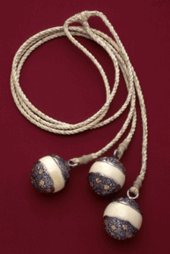Bolas
.jpg) A hunter using bolas while mounted on a horse.  River Plate Indians with Bolas (Hendrick Ottsen, 1603) |
Bolas (from Spanish bola, "ball", also known as boleadoras, or Inca ayllo) are a throwing weapon superficially similar to the surujin, made of weights on the ends of interconnected cords, designed to capture animals by entangling their legs. They were most famously used by the Australian Aborigines, but have been found in excavations of Pre-Columbian settlements, especially in Patagonia, where indigenous peoples used them to catch 200 pound guanaco (llama-like mammals) and ñandú (birds). They were also used in battle by the Inca army. They have also been found as a modern-day tool in North America at the Calico Early Man Site.
Use
Gauchos use boleadoras to capture running cattle or game. Depending on the exact design, the thrower grasps the boleadora by one of the weights or by the nexus of the cords. He gives the balls momentum by swinging them and then releases the boleadora. The weapon is usually used to entangle the animal's legs, but when thrown with enough force might even inflict damage (i.e., breaking a bone).
Design

There is no uniform design; most bolas have two or three balls, but there are versions of up to eight or nine. Some bolas have balls of equal weight, others vary the knot and cord. Gauchos use bolas made of braided leather cords with wooden balls or small leather sacks full of stones at the ends of the cords.
Bolas can be named depending on the number of weights used:
- Perdida (one weight)
- Avestrucera or ñanducera (two weights)
- Boleadora (three weights)
- Kiipooyaq (Inuit name for bolas with three or more weights[1][2])
Bolas of three weights are usually designed with two shorter cords with heavier weights, and one longer cord with a light weight. The heavier weights fly at the front parallel to each other, hit either side of the legs, and the lighter weight goes around, wrapping up the legs.
Other unrelated versions include qilumitautit, the bolas of the Inuit, made of sinew and bone weights and used to capture water birds.
See also
- Bolas spiders, which swing a sticky web blob at the end of a web line to capture prey.